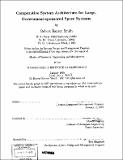Comparative system architecture for large, government-sponsored space systems
Author(s)
Smith, Robert Hanson, 1964-
DownloadFull printable version (7.978Mb)
Advisor
Edward Crawley.
Terms of use
Metadata
Show full item recordAbstract
The fundamental issues in any discussion of a proposed system architecture must involve the relative quality of the architecture when compared to other proposals and the architecture's ability to satisfy the needs and abilities of the customer, the system environment and the system developer. While the latter issue can often be easily addressed through standard system architecture methods, the former comparative issue can often be quite difficult due to some of the uncertainty and ambiguity in the· relative merit of system architecture factors. In large government-funded space system architectures, which often span years of development/production and cost tens of billions of dollars, this difficulty is especially apparent and highlights the need for an effective method for comparative evaluation. This thesis research has developed a unique tool by which comparisons of system architectures ca.n be made. This technique, which is a. fuzzy set extension of the Axiomatic Design method, has the ability to incorporate and capture both technical and non-technical parameters that are vital to the comparison process. This tool is effectively applied to architectural proposals for the human exploration of Mars. As supporting objectives, the research examines the structure of advanced technology developments, explores the affects of the government budgetary process and comments on the government/contractor managerial relationship as they pertain to space system architectures.
Description
Thesis (S.M.)--Massachusetts Institute of Technology, System Design and Management Program, 1999. Includes bibliographical references (leaves 108-119).
Date issued
1999Publisher
Massachusetts Institute of Technology
Keywords
System Design and Management Program